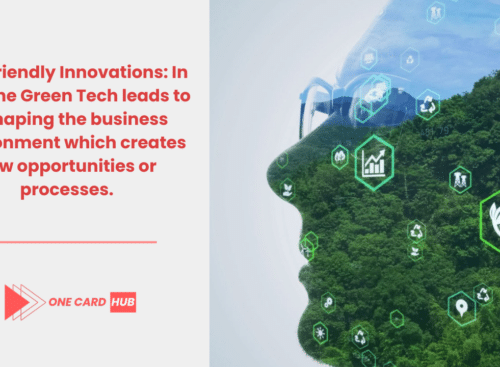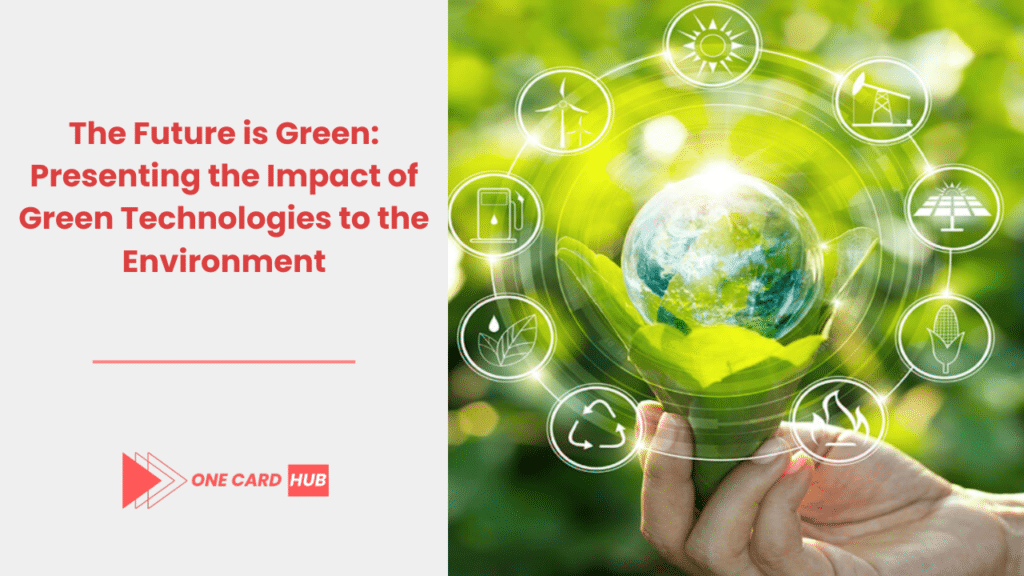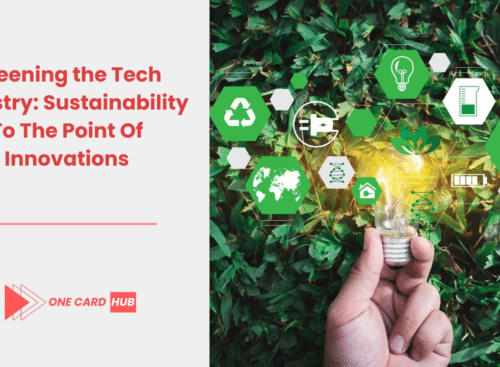
The Future is Green: Presenting the Impact of Green Technologies to the Environment

Leaving further negative impact of human activities on environment the global community becomes ingenuous being aware of environment. With this , the tech industry is aligning itself with sustainability. Technologies such as eco-friendly solutions and shortening carbon footprints in the process of being developed, and are now at the forefront of current technology consideration as environmental sustainability is gaining momentum. The next part of the course will focus on what is currently being carried out in the tech sector in terms of sustainability, and it will take into consideration some activities that are leading the way with their efforts to use resources properly and the path that has to be followed towards a green future.
Renewable energy as a part of the companies' tech operations.
The core of sustainability among various technology sectors is the move to renewable sources of energy. On the other hand, even organizations that are yet to go completely green have started clean energy commitment. Google and Apple for example have made remarkable progress towards this all renewable power mark. Be it emissions reduction or the setting of a benchmark for others in the market to emulate, this is just a few of the many benefits that the green building movement brings.
Energy-Efficient Hardware and Software
Among the key aspects of development one needs to note the creation of energy-efficient hardware that is undergoing side by side. The advent of processor innovations, temperature control improvements, and power management yield an adjusted power usage of gadgets and data centers. As the software code gets optimized for energy
efficiency, there can be drastic reduction of the energy footprint over the computer operations. Ultimately, this would not make the software just faster, but also green in use.
E-Waste Management and Recycling
E-waste, consisting of electronics which have gone in for disposal, is terrible for the environment because of the toxic substances it contains and its fast rate of generation. E-waste management involves gradually better practices of the tech industry to resolve this issue. Also, design of more durable products is on the plate of the tech industry to respond to this challenge. Programs for recycling and introducing a circular economy with the goal of not shedding waste and reusing electronic components are gradually gaining the traction forming as the basic principle.
Sustainable Supply Chains
At the same time with the progress, sustainability in the tech industry includes a broader reach onto supply chains where there is the increasing application of responsible sourcing of materials. For instance: among others the organization seeks to maximize the use of conflict free minerals, it’s concerned about fair labor conditions and greenhouse gas emissions that are associated with goods transportation. Ethical supply chains not only respect living nature but they also promote corporate social responsibility.
Green Data Centers
Data centers are standing at the core of the digital commerce but do not forget that they account for the bulk of energy consumption as well. There are various ways in which the industry innovates to develop green data centers; i.e., the use of environmentally-friendly energy sources such as renewables, effective air conditioning systems, and even designs that cut energy use. By searching colder locations some companies naturally reduce the need for cooling or using heat generated by data centers for heating the buildings near by, such innovative steps display the fact that not only technological but also nature-friendly ways to sustainability may be found.
Challenges and Barriers
The road to sustainability becomes more and more generally accepted, pedestrians and drivers still encounter a number of obstacles. The foremost barrier are the high cost
of green technologies and the requirement of across the industry standard. It is unexpected by people at what pace Sustainable solutions are scalable. Furthermore, the aim to balance the technological developments, and environmental issues requires changes in the organizational culture with a long-term benefits essence that is to be priority than a short-term gains.
The Contributions of Clients and Governance
Very expectedly, customers are expecting eco friendly products and that is leading to changes in the product designs which are being introduced in the tech industry. The same applies across borders – equally important are regulations and policies which either stimulate green initiatives by means of tax breaks or penalize those operating within the context of the environmental standards.
Looking Ahead: Innovation is the main factor for our sustainable future now and in the long run.
It is certain that the future technology sector will be green, as sustainability becomes an essential component of further advancement. The emerging technologies such as AI and blockchain provide novel approaches of addressing environmental problems proposing for example solutions on how to make full utilization of the available resources or to regain the worn out trust in supply chains. Technological industries have reached the point when people get to choose between profitability and eco-friendly solutions. Besides environmental benefits of creeping towards sustainability, leading to newer heights in growth and innovation is also one of the reasons behind this commitment. The realm of sustainable technology involves continuous learning and offers a wide range of benefits. Through the implementation of renewables, the search for efficiency and the processing of environmentally aware activities in the sector, it is becoming clear that the sector is heading to a more sustainable direction. With technology entering in every morale of our lives at present days, its function in prolonging environment sustainable is therefore become an indispensable component. The new tech green is the path ahead and the industry is showing that technology and environmental stewardship join two hands for the benefit.
Sustainability Green Value of Tech Companies
Modulating a culture that not only puts sustainability first but also is a good thing for the tech business organizations that want to achieve a major environmental victory. It consists of not only tightening green policies but also involving employees in all levels to enable them get acquainted and endorse sustainability practices. Through provision of incentives for green ventures, organization of sustainability workshops, and promotion of intelligent development of eco-bottom line personnel system, companies can create a culture where sustainability becomes a core value.
New breakthroughs in Clean Energy Technologies are infiltrating the industry and reviewing market options.
It also reduces the power needs of households, so they become more energy-efficient and independent. While there are innovations in solar power, wind energy and battery storage which make the Renewable power more efficient and cheap, they are also making its accessibility easier. Tech companies are pouring immense financial resources into this vertical, not only for powering their own businesses with sustainable energy, but also to shape global economy and encourage a more green culture.
The emergence and growth of Green Tech Startups and Renewable Energies are factors that are contributing to high levels of innovations.
The fresh flow of eco-friendly tech startups is topped up with the appearance of new companies that bring novel solutions regarding environmental situation. These startups are on the mission of constructing eco friendly plastics, non-toxic materials, intelligent energy management technologies and even carbon capture systems. Boosting the tech sector’s involvement in such startups via investments, mentorship, and partnerships is a key highlight in bridging the gap between the novel sustainable ideas and products’ availability in the market.
Challenges and Opportunities
Even though the tech industry's shift towards sustainability arises with lots of positives, many challenges come along which to overcome too is very essential. The high cost of investments in green practices, the need of the international community to unite in making sustainable practices universal around the world, and the challenge of how environmental impact should be truly calculated and reported are the main topics that are studied by experts in this field. It is possible achieving the goals through common efforts of the tech companies, government institutions, NGOs and consumers only.
Beyond subsidies, consistent policies and regulations related to renewables such as feed-in tariffs, support mechanisms, renewable portfolio standards, and net metering are critical for facilitating increased adoption.
Sustainability in the tech industry has government regulations and policies as significant drivers to adoption and making mandatory to be implemented. Collaborative efforts, for instance mandated e-waste recycling, incentives for clean energy use, and carbon pricing, can achieve remarkable results in environmental conservation. Additionally, tech industry can push for policies that impress sustainability, taking this opportunity to be the unsung hero and champion the cause of maintaining smart planet.
Education and Awareness
Educating both consumers and the upcoming generation of tech workers on why sustainability should be important is a vital component of the long-term sustainability goals since it gives relevant information to these unique groups of people. Tech companies can take advantage or their platforms and reinforce those issues regarding environment and how to live healthily for it. Moreover, green technology interaction with STEM can help to create next generation inventors who would consider the planet as they design and decide.
Looking Forward
Thinking into the future, technological rehabilitation and sustainability point to one more significant issue. The tech industry is deeply invested and committed to coming up with several environmental solution ideas with the continuous innovation and passion to green practices as its driving factor and lead to critical ways to save the planet. By cooperating, connecting with the cutting-edge, and prioritizing sustainability, the tech sector can be the core driving force in attaining a prosperous and ecofriendly future for every living individual. In conclusion, "The Future is Green: Smart Tech and the Sustainable Future"" illustrates what the technological businesses can offer and must provide about sustainability. The IT sector needs to provide solutions to the problem of green computing, sustainable software engineering, the publishing of circular economy and the recognition of green v technology through this way the industry can make a big difference in the world. While the way to a sustainable society is long and challenging, with little steps and teamwork the high-tech sector can contribute to leaving behind a beautiful, cleaner world.
FAQ: be sustainable in IT tech
What is green computing?
Green computers, also called ecologically sustainable computing practices or green I (Information) T (Technology), indicate those design, manufacturing, using and disposing of computers, servers and even subsystems like screens, printers, storage devices, and communications and networks devices in a competent and efficient manner which has little or no impact on the environment.
Green computers, also called ecologically sustainable computing practices or green I (Information) T (Technology), indicate those design, manufacturing, using and disposing of computers, servers and even subsystems like screens, printers, storage devices, and communications and networks devices in a competent and efficient manner which has little or no impact on the environment.
Why should we strive for em-waste reduction?
Decreasing e-waste is vital because of the same reasons, electronic waste has hazardous substances that can become a threat to the environment consequences which may also lead to public health hazards. Correct electronics waste management processes allow material conservation, reduce pollution and energy use, and, thereby, decrease greenhouse gases.
Decreasing e-waste is vital because of the same reasons, electronic waste has hazardous substances that can become a threat to the environment consequences which may also lead to public health hazards. Correct electronics waste management processes allow material conservation, reduce pollution and energy use, and, thereby, decrease greenhouse gases.
What principle should serve as the basis for sustainability in software?
Sustainable software works with lower energy consumption to be still operational, spread the longevity on the device they are run on, and is overall more efficient in its lifecycle. This could be attained by writing the codes for better performance, reducing consumption of recourses, and designing pieces that could last longer and recyclable.
Sustainable software works with lower energy consumption to be still operational, spread the longevity on the device they are run on, and is overall more efficient in its lifecycle. This could be attained by writing the codes for better performance, reducing consumption of recourses, and designing pieces that could last longer and recyclable.
What existential stop-position do progressive technologies accomplish in the case of environment?
The future public comes into being with technologies such as IoT (Internet of Things), blockchain, artificial intelligence (AI), and clean energy innovations. These technologies will help to minimize the use of resources, reduce the creation of waste, optimize energy efficiency, and enable to have transparent and accessible solutions which provide the environmental sustainability of the future.
The future public comes into being with technologies such as IoT (Internet of Things), blockchain, artificial intelligence (AI), and clean energy innovations. These technologies will help to minimize the use of resources, reduce the creation of waste, optimize energy efficiency, and enable to have transparent and accessible solutions which provide the environmental sustainability of the future.
In what aspect does a circular economy converge with tech nowadays?
The circular economy in the era of tech defines the reduction of waste flows while resources are made to work longer rather than being thrown away. For instance, product development for longer-lasting, repairable, and recycling is to use remanufactured and components in the process, and to offer more of product-as-a-service models to extend the lifetime span of technology products.
The circular economy in the era of tech defines the reduction of waste flows while resources are made to work longer rather than being thrown away. For instance, product development for longer-lasting, repairable, and recycling is to use remanufactured and components in the process, and to offer more of product-as-a-service models to extend the lifetime span of technology products.
In isolation, what actions do individuals have to maintain the sustainable recycling system?
Rationality should be the one to support sustainable tech practices by buying eco-friendly and repairable devices, disposing of their old electronics in an environmentally-friendly way, lowering their energy consumption by using low consumption setting. Also, they should prefer companies and products that are eco-friendly.
Rationality should be the one to support sustainable tech practices by buying eco-friendly and repairable devices, disposing of their old electronics in an environmentally-friendly way, lowering their energy consumption by using low consumption setting. Also, they should prefer companies and products that are eco-friendly.
Are there underlying practices for green technology?
No doubt, there are several technologies certifications, for instance, the ENERGY STAR for energy efficient products, and EPEAT for electronic products that meet specific environmental requirements. Also, there is a Green Seal which certifies that the products and services are environmentally friendly.
No doubt, there are several technologies certifications, for instance, the ENERGY STAR for energy efficient products, and EPEAT for electronic products that meet specific environmental requirements. Also, there is a Green Seal which certifies that the products and services are environmentally friendly.
Why are tech firms stimulated to pick up methods of sustainability?
Sustainability through technology adoption is financially beneficial due to lowered consumption of energy and natural resources, as well as augmented reputation of environment friendly brands. Moreover, companies enjoy adherence to environmental regulations, and better chances of attracting both customers and employees who are focused on sustainability.
Sustainability through technology adoption is financially beneficial due to lowered consumption of energy and natural resources, as well as augmented reputation of environment friendly brands. Moreover, companies enjoy adherence to environmental regulations, and better chances of attracting both customers and employees who are focused on sustainability.
The validity of online tech education has led to the debate that can this education system be sustainable?
Yes, online tech education is the choice of the day because it doesn't need physical materials to be taken to the classrooms, it saves the need to travel and it is more energy effective than traditional classroom-based education, hence, it is becoming the best option for learning as it is sustainable.
Yes, online tech education is the choice of the day because it doesn't need physical materials to be taken to the classrooms, it saves the need to travel and it is more energy effective than traditional classroom-based education, hence, it is becoming the best option for learning as it is sustainable.
What forthcoming challenges that technology companies have on their way to be more greener?
Obstacles to overcome the starting investments for effective green innovation, a culture shift especially in the existing companies, constant research of innovations and application and regulations, analyze and decrease both social and indirect environmental impacts and to ensure that the whole supply chain is sustainable are some of the challenges faced.
Obstacles to overcome the starting investments for effective green innovation, a culture shift especially in the existing companies, constant research of innovations and application and regulations, analyze and decrease both social and indirect environmental impacts and to ensure that the whole supply chain is sustainable are some of the challenges faced.



Related posts